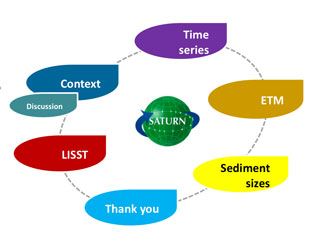You are here
Graduate Student Sets Trend for Electronic Posters
12/16/09 Portland, Ore.
Poster board and push pins are typical supplies one needs when presenting at a poster session. Not so for Nirzwan Bandolin, a graduate student at the Oregon Health & Science University. What he needed was an electrical outlet. Bandolin was the only student presenter among the electronic posters at the 2009 Coastal and Estuarine Research Federation (CERF) 20th Biennial Conference.
 Artwork from Bandolin’s electronic poster that contained multiple storylines linking to the research of sediment dynamics.
Artwork from Bandolin’s electronic poster that contained multiple storylines linking to the research of sediment dynamics.
Using a computer and 42” flat panel display monitor, Bandolin presented research about “Long-term time series of sediment concentrations in the Columbia River.” His research reflected a collaborative effort with his thesis advisor António Baptista, Ph.D. and the CMOP field team members Michael Wilkin, Katie Rathmell, and Greta Klungness.
“An electronic poster allows you to go much more in depth about your research then a typical poster,” Bandolin said. “I was able to create multiple storylines to discuss time series, Estuary Turbidity Maxima, sediment size, and the technology used to study sediment dynamics in the Columbia River estuary.”
This year’s CERF conference theme was “Estuaries and Coasts in a Changing World.” The theme reflected the mix of scientific and management-oriented presentations as well as a focus on regional issues of the Pacific Northwest. There were 974 oral and 408 poster presentations in ten concurrent sessions. The electronic poster format was a new mode of presentation for CERF.
“We realize this presentation required extra effort in its creation, and required someone willing to go beyond the normal level of effort,” said Walt Nelson, conference poster chair. “Nirzwan was willing to try this presentation format for his poster, and did a very fine job of conveying complex environmental information on his topic.”
The research Bandolin presented is part of his overall thesis work. He hypothesizes that sediment data is going to be one of the most important links between the physics in hydrodynamic models to the actual biology and chemistry in the estuary.
Bandolin will continue to enhance his electronic poster as more data and findings become available. He plans on presenting the poster at a sediment conference coming up later this spring.
Written by Jeff Schilling






